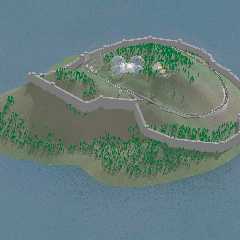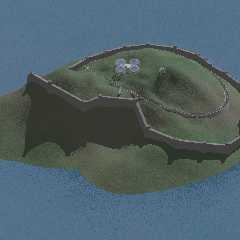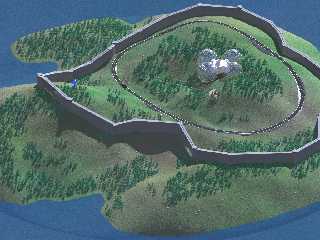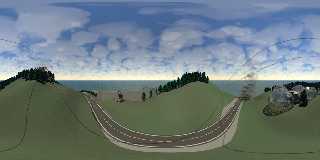 |
 |
|
 |
|
 |
|  |
|  |
|
 |
|
 |
|  |
|  |
|
 |
Here's the scene I was talking about in the other thread where an value
of 1 for assumed_gamma was resulting in the image being too bright and
washed out. Either I have to modify TerraPOV's atmospheric media, or I
have to modify every other object in my scene.
-Mike
Post a reply to this message
Attachments:
Download 'gh_scene_outdoors_cubemap_gamma_on.png' (1546 KB)
Preview of image 'gh_scene_outdoors_cubemap_gamma_on.png'

|
 |
|  |
|  |
|
 |
|
 |
|  |
|  |
|
 |
SharkD schrieb:
> Here's the scene I was talking about in the other thread where an value
> of 1 for assumed_gamma was resulting in the image being too bright and
> washed out. Either I have to modify TerraPOV's atmospheric media, or I
> have to modify every other object in my scene.
To me this looks like you're using an awful lot of ambient.
Post a reply to this message
|
 |
|  |
|  |
|
 |
|
 |
|  |
|  |
|
 |
clipka wrote:
> To me this looks like you're using an awful lot of ambient.
Wow! That made a big difference! However, the colors still seem sort of
washed out. I've attached the new render as well as an old one from
before I lowered the gamma. I prefer the crisp, saturated colors of the
older image.
- Mike
Post a reply to this message
Attachments:
Download 'gh_scene_outdoors_cubemap.png' (1455 KB)
Download 'gh_scene_outdoors_saturated.png' (1507 KB)
Preview of image 'gh_scene_outdoors_cubemap.png'

Preview of image 'gh_scene_outdoors_saturated.png'

|
 |
|  |
|  |
|
 |
From: Thomas de Groot
Subject: Re: Assumed_gamma, too bright and washed out
Date: 4 Sep 2009 05:18:04
Message: <4aa0db4c@news.povray.org>
|
|
 |
|  |
|  |
|
 |
This last one looks alright to me.
Thomas
Post a reply to this message
|
 |
|  |
|  |
|
 |
|
 |
|  |
|  |
|
 |
Here's my latest render. The scene uses two media for the sky: one for
the clouds and one for the haze. Either one of them by itself renders
pretty fast, but together they cause the render to take a *really* long
time.
-Mike
Post a reply to this message
Attachments:
Download 'gh_scene_outdoors_cubemap_atmos_gamma_b.png' (533 KB)
Preview of image 'gh_scene_outdoors_cubemap_atmos_gamma_b.png'

|
 |
|  |
|  |
|
 |
|
 |
|  |
|  |
|
 |
SharkD a écrit :
> Here's my latest render. The scene uses two media for the sky: one for
> the clouds and one for the haze. Either one of them by itself renders
> pretty fast, but together they cause the render to take a *really* long
> time.
>
> -Mike
>
> ------------------------------------------------------------------------
>
Are they overlaping or sharing the same container?
I'd try with containers that are distinct, with some gap between them.
That way, you compute one media, them, somewhat further, you compute the
other one. The haze could easily use a low samples value, like samples
3, while the clouds will use a larger samples value, like samples 30.
Alain
Post a reply to this message
|
 |
|  |
|  |
|
 |
|
 |
|  |
|  |
|
 |
Alain wrote:
> Are they overlaping or sharing the same container?
>
> I'd try with containers that are distinct, with some gap between them.
> That way, you compute one media, them, somewhat further, you compute the
> other one. The haze could easily use a low samples value, like samples
> 3, while the clouds will use a larger samples value, like samples 30.
They each use their own container. The smaller container is inside the
larger. If it makes the scene render faster, I would like to change them
so they use the same container. Not sure how to go about doing this
though. I also don't want to make them use distinct volumes. Their media
should "add".
-Mike
Post a reply to this message
|
 |
|  |
|  |
|
 |
|
 |
|  |
|  |
|
 |
SharkD a écrit :
> Alain wrote:
>> Are they overlaping or sharing the same container?
>>
>> I'd try with containers that are distinct, with some gap between them.
>> That way, you compute one media, them, somewhat further, you compute
>> the other one. The haze could easily use a low samples value, like
>> samples 3, while the clouds will use a larger samples value, like
>> samples 30.
>
> They each use their own container. The smaller container is inside the
> larger. If it makes the scene render faster, I would like to change them
> so they use the same container. Not sure how to go about doing this
> though. I also don't want to make them use distinct volumes. Their media
> should "add".
>
> -Mike
This forces both medias to use the same number of samples.
Also, the sampling for the clouds probably continue into the haze media.
To use only one container, you'll need to add another density pattern.
One media with a single density for the haze.
One media with two densities for the clouds. The new pttern can be
"planar" with a map similar to: (added in the cloud's media block)
density{planar {color_map{ [0 rgb 0][0.02 rgb 1] }}}
To have the clouds go sharply from invisible to full density.
Two media in a container add.
A media with two densities multiply the densities.
Alain
Post a reply to this message
|
 |
|  |
|  |
|
 |
|
 |
|  |
|  |
|
 |
Alain wrote:
> This forces both medias to use the same number of samples.
> Also, the sampling for the clouds probably continue into the haze media.
>
> To use only one container, you'll need to add another density pattern.
>
> One media with a single density for the haze.
> One media with two densities for the clouds. The new pttern can be
> "planar" with a map similar to: (added in the cloud's media block)
> density{planar {color_map{ [0 rgb 0][0.02 rgb 1] }}}
> To have the clouds go sharply from invisible to full density.
>
> Two media in a container add.
> A media with two densities multiply the densities.
>
>
> Alain
Actually I am using concentric spheres. The media attached to the
smaller sphere uses an onion pattern, so I'll need to figure out how to
limit it to just the assigned area instead of repeating.
-Mike
Post a reply to this message
|
 |
|  |
|  |
|
 |
|
 |
|  |
|  |
|
 |
Here is the media for the cloud sphere, which is the inner of the two
volumes. What I need is to be able to "clip" the media to "InnerRadius"
and "OuterRadius" so that I can then simply copy/move the media to the
larger atmosphere sphere.
-Mike
//BEGIN
#local InnerRadius = EarthRadius + CloudMinRad;
#local OuterRadius = InnerRadius + CloudMaxRad;
#local BoundRadius = sin(acos(EarthRadius/OuterRadius)) * OuterRadius;
#local ScaleAmount = Width/2;
// #local testpattern = function {mod(sqrt(Sqr(X) + Sqr(Y) + Sqr(Z)), 1.0)}
#local CloudPigment = pigment
{
average
pigment_map
{
[2 onion scale CloudMaxRad/ScaleAmount phase
-mod(OuterRadius,CloudMaxRad)/CloudMaxRad/ScaleAmount]
[2 granite scale 1024 * 32/ScaleAmount]
}
}
#local CloudMedia = media
{
scattering {1, 0.5 * 1/ScaleAmount / 320}
method 3
intervals 1
// samples 30 //30, 100
samples 4
density
{
pigment_pattern {CloudPigment}
density_map {[0.60 rgb 0][0.61 rgb 1]}
}
}
#local CloudSphere = difference
{
sphere {0, OuterRadius}
sphere {0, InnerRadius}
bounded_by {cylinder {<0,EarthRadius,0,>, <0,OuterRadius,0,>,
BoundRadius}}
hollow
material
{
texture {pigment {rgbt 1}}
interior
{
media {CloudMedia}
}
scale ScaleAmount
}
translate -y * EarthRadius
}
//END
Post a reply to this message
|
 |
|  |
|  |
|
 |
|
 |
|  |




![]()